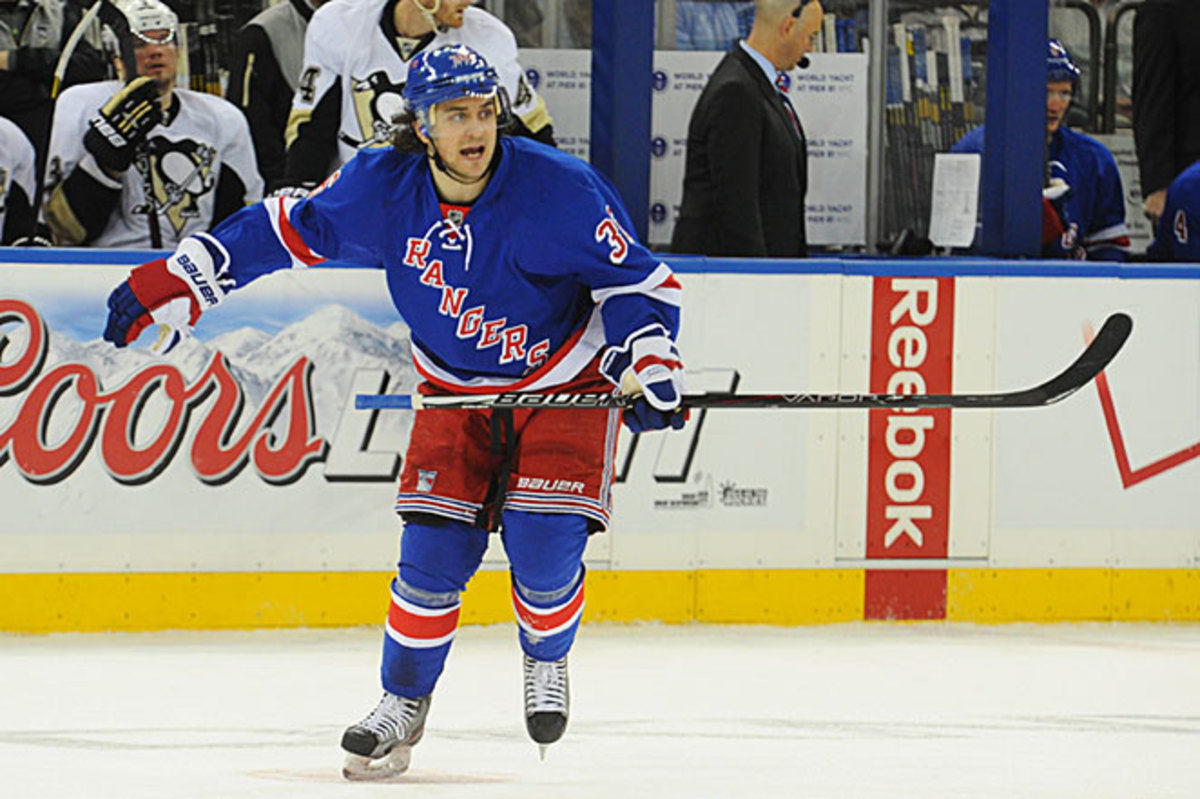Shootout skill a key factor in NHL deadline deals

Recent NHL returnee Mats Zuccarello may be small, but he could come up big for the Rangers.
Will Schneekloth/Icon SMI
When it comes to the big trades, the ones that grab headlines and warrant breaking news alerts to your phone, it doesn't take a genius to analyze the pros and cons. How a pro like Jarome Iginla would help the East-leading Pittsburgh Penguins, or how speedy winger Marian Gaborik could boost Columbus's Western Conference-worst offense. It's easy to see why the Bruins, just a point out of the Northwest Division lead, would benefit from having Jaromir Jagr on the ice; and why the Lightning, who let in 2.89 goals per game, would make a play for Ben Bishop, a goalie for the Senators, a team that gives up the fewest goals per game (2.08).
HACKEL:Pierre McGuire's four most significant trades
But those were just a small handful of the three dozen or so deals that went down in the 10 days leading to the April 3 deadline. Then there are the other moves, the ones that might not make a splash, but can speak volumes for what teams, particularly bubble teams (which I define as being within four points of eighth place), are looking for with just a dozen games to go. In this shortened season, each point means even more in the standings, however it may come -- in regulation, in overtime or even in the shootout.
TRADE TRACKER:All deals from March 24 to deadline
Since its introduction in 2005-06, the shootout has been a mildly controversial addition to the game. It's drawn the ire of people who don't want an individual skills competition muddying a team game, a detail that doesn't bother the millions of fans who love the dazzle, the spectacle of the one-on-one battle. But it's because of the significance it carries -- a point in the standings is at stake-- that the debate continues to rage on.
How important has the shootout been? In 2006, the Maple Leafs missed the playoffs by two points, and they had lost seven shootouts over the course of the season. A year later, déjà vu: the Leafs, who had lost another seven shootouts, missed the postseason by just one point. Colorado, too, missed by a point in 2007 after dropping four shootouts that season.
In 2010, the league changed a rule to exclude shootout wins from breaking a tie in the standings. The move was spurred by the Florida Panthers, who would have made the playoffs in 2009 had it not been for Montreal's seven shootout wins that season. So, while the shootout might mean just a little less than it did before the change, the importance of points is still the same.
And by the looks of the transaction sheets, the attention being given to the shootout doesn't get lost. A handful of dangle-and-deke specialists -- Mike Santorelli, Michal Handzus and Jussi Jokinen, to name a few -- found new homes near the deadline, which demonstrates just how tight GMs expect these playoff races will be. With five teams sitting on the bubble in the East and eight in the West, the extra point that any of them could contribute in a shootout could very well make all the difference by season's end.
It wouldn't be the first time.
Recall April 11, 2010, the closing day of the NHL's regular season. In Philadelphia, the Flyers and the Rangers, tied with 86 points each after 81 games, were playing for their postseason lives: Winner moves on. loser goes home. After 65 minutes, the score was knotted at 1-1, and the balance of the two teams' seasons hung on a shootout. After Flyers forwards Danny Briere and Claude Giroux put shots past goalie Henrik Lundqvist, the Rangers' fate was on the stick of Olli Jokinen, but Philadelphia goalie Brian Boucher saved the shot and the Flyers' playoff hopes.
Armed with the memory of getting burned in 2010, the Rangers, currently eighth in the East, made a couple of moves last week that could help them avoid that same fate, if it happens upon them again. On March 28, they signed pint-sized shootout whiz Mats Zuccarello, who as an NHL rookie in 2010-11 went 5-for-9 for New York. The Rangers also picked up Sharks winger Ryane Clowe, whose many assets include a pretty good shootout record. Though he had gone goalless with San Jose this season, the winger is 16-for-41 over his eight-year career, good for 39 percent.
Since the shootout's introduction, the average success rate for shooters has been 32.9 percent. During this deadline frenzy season, eight players with career averages over that mark (at least 10 attempts) found new homes: Zuccarello (50%), Santorelli (50%), Handzus (47.5%), Jokinen (45.5%), Clowe (39%), Jason Pominville (38.3%), Raffi Torres (36.4%) and Derek Roy (34.5%). Two players that average just under 32.9 percent -- Steve Sullivan (32.4%) and Martin Erat (31.9%) -- were also traded. And the landing spots for these players?
All but three went to bubble teams.
Of course, many of these players bring more than a pair of nifty mitts. Clowe brings an edge and 20-goal potential to the Rangers. Handzus will kill penalties and be good on draws for Chicago. In Minnesota, veteran winger Pominville can play the point on the power play and he brings 200-foot ice awareness. But their worth in the shootout can be tangible.
In the end, it comes down to one question: Can a player help his team win? Well, for these above-average shootout artists, they have at least one number that suggests they can.
































